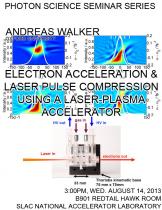Andreas Walker, Oxford University
Scientist have used accelerated particles to discover new particles, study fundamental qualities, and for medical applications successfully for many decades using radio-frequency electro-magnetic fields. While current machines work well and are absolutely essential for fundamental research and the treatment of patients, accelerators using electromagnetic fields within a plasma accelerator have the potential to reduce the cost and size of future machines by orders of magnitude.
In this talk, I will concentrate on plasma acceleration using femtosecond short laser pulses. This so-called Laser Wakefield Acceleration (LWFA), in which a laser beam is focused onto a target of gas or plasma, can produce high energy electron bunches of energies beyond GeV within just a few millimeters. I will give an overview of recent LWFA experiments and then focus on one particular experiment performed at the Astra-Gemini laser facility using a discharge waveguide capillary. The experiment created stable near GeV scale electron beams using a 60 TW laser beam. Methods to fully characterize the laser light with simultaneous electron acceleration are presented as well as two precise methods of detection of electron energy.





